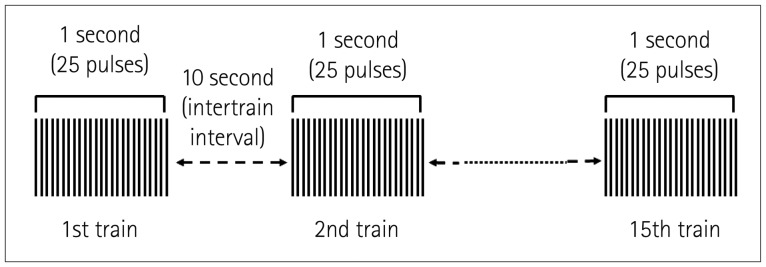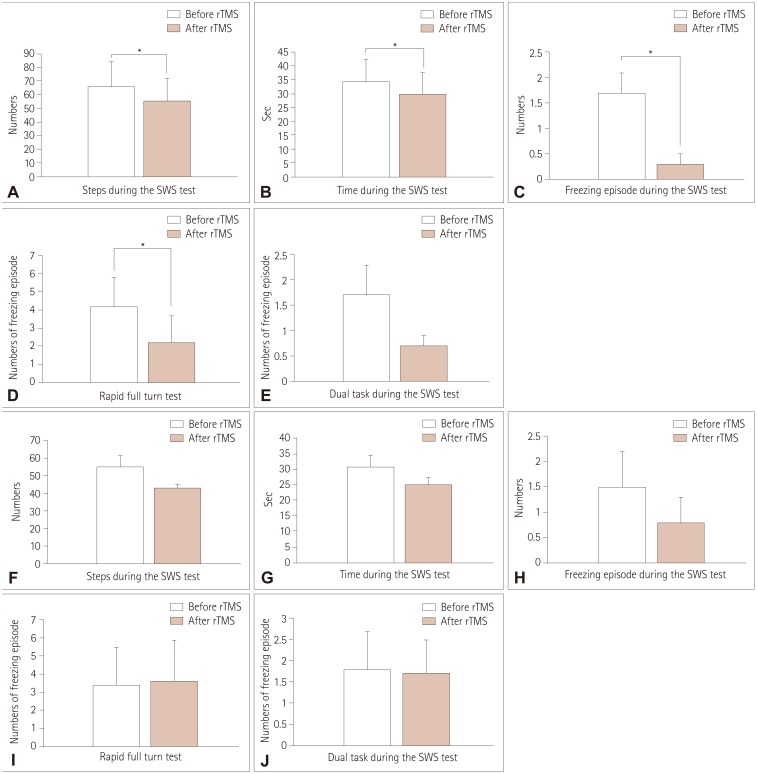J Clin Neurol.
2018 Jul;14(3):320-326. 10.3988/jcn.2018.14.3.320.
Stimulation in Supplementary Motor Area Versus Motor Cortex for Freezing of Gait in Parkinson's Disease
- Affiliations
-
- 1Department of Neurology, Inje University College of Medicine, Busan, Korea.
- 2Dementia and Neurodegenerative Disease Research Center, Inje University, Busan, Korea.
- 3Department of Neurosurgery, Inje University College of Medicine, Busan, Korea.
- 4Department of Neurology, Dongtan Sacred Heart Hospital, Hallym University College of Medicine, Hwaseong, Korea. sukyunkang@hanmail.net
- KMID: 2415047
- DOI: http://doi.org/10.3988/jcn.2018.14.3.320
Abstract
- BACKGROUND AND PURPOSE
Freezing of gait (FOG) is a frustrating problem in Parkinson's disease (PD) for which there is no effective treatment. Our aim was to find brain stimulation areas showing greater responses for reducing FOG.
METHODS
Twelve PD patients with FOG were selected for inclusion. We explored the therapeutic effect of repetitive transcranial magnetic stimulation (rTMS) in the supplementary motor area (SMA) and the motor cortex (MC). We measured the number of steps, completion time, and freezing episodes during the stand-walk-sit test before and after rTMS treatment. We also tested freezing episodes in two FOG-provoking tasks.
RESULTS
There was a trend for a greater reduction in freezing episodes with SMA stimulation than MC stimulation (p=0.071). FOG was significantly improved after SMA stimulation (p < 0.05) but not after MC stimulation.
CONCLUSIONS
Our study suggests that the SMA is a more-appropriate target for brain stimulation when treating PD patients with FOG. This study provides evidence that stimulating the SMA using rTMS is beneficial to FOG, which might be useful for future developments of therapeutic strategies.
Keyword
MeSH Terms
Figure
Reference
-
1. Nutt JG, Bloem BR, Giladi N, Hallett M, Horak FB, Nieuwboer A. Freezing of gait: moving forward on a mysterious clinical phenomenon. Lancet Neurol. 2011; 10:734–744. PMID: 21777828.
Article2. Giladi N, McDermott MP, Fahn S, Przedborski S, Jankovic J, Stern M, et al. Freezing of gait in PD: prospective assessment in the DATATOP cohort. Neurology. 2001; 56:1712–1721. PMID: 11425939.
Article3. Macht M, Kaussner Y, Möller JC, Stiasny-Kolster K, Eggert KM, Krüger HP, et al. Predictors of freezing in Parkinson's disease: a survey of 6,620 patients. Mov Disord. 2007; 22:953–956. PMID: 17377927.
Article4. Contreras A, Grandas F. Risk factors for freezing of gait in Parkinson's disease. J Neurol Sci. 2012; 320:66–71. PMID: 22795382.
Article5. Ou R, Guo X, Song W, Cao B, Yang J, Wei Q, et al. Freezing of gait in Chinese patients with Parkinson disease. J Neurol Sci. 2014; 345:56–60. PMID: 25043665.
Article6. Perez-Lloret S, Negre-Pages L, Damier P, Delval A, Derkinderen P, Destée A, et al. Prevalence, determinants, and effect on quality of life of freezing of gait in Parkinson disease. JAMA Neurol. 2014; 71:884–890. PMID: 24839938.
Article7. Fietzek UM, Zwosta J, Schroeteler FE, Ziegler K, Ceballos-Baumann AO. Levodopa changes the severity of freezing in Parkinson's disease. Parkinsonism Relat Disord. 2013; 19:894–896. PMID: 23642712.
Article8. Nonnekes J, Snijders AH, Nutt JG, Deuschl G, Giladi N, Bloem BR. Freezing of gait: a practical approach to management. Lancet Neurol. 2015; 14:768–778. PMID: 26018593.
Article9. Schlenstedt C, Shalash A, Muthuraman M, Falk D, Witt K, Deuschl G. Effect of high-frequency subthalamic neurostimulation on gait and freezing of gait in Parkinson's disease: a systematic review and metaanalysis. Eur J Neurol. 2017; 24:18–26. PMID: 27766724.
Article10. Xie T, Kang UJ, Warnke P. Effect of stimulation frequency on immediate freezing of gait in newly activated STN DBS in Parkinson's disease. J Neurol Neurosurg Psychiatry. 2012; 83:1015–1017. PMID: 22696586.
Article11. Okuma Y. Practical approach to freezing of gait in Parkinson's disease. Pract Neurol. 2014; 14:222–230. PMID: 24532673.
Article12. Cirillo G, Di Pino G, Capone F, Ranieri F, Florio L, Todisco V, et al. Neurobiological after-effects of non-invasive brain stimulation. Brain Stimul. 2017; 10:1–18. PMID: 27931886.
Article13. Henrich-Noack P, Sergeeva EG, Sabel BA. Non-invasive electrical brain stimulation: from acute to late-stage treatment of central nervous system damage. Neural Regen Res. 2017; 12:1590–1594. PMID: 29171414.
Article14. Chou YH, Hickey PT, Sundman M, Song AW, Chen NK. Effects of repetitive transcranial magnetic stimulation on motor symptoms in Parkinson disease: a systematic review and meta-analysis. JAMA Neurol. 2015; 72:432–440. PMID: 25686212.15. Chung CL, Mak MK. Effect of repetitive transcranial magnetic stimulation on physical function and motor signs in Parkinson's disease: a systematic review and meta-analysis. Brain Stimul. 2016; 9:475–487. PMID: 27117282.
Article16. Kim MS, Chang WH, Cho JW, Youn J, Kim YK, Kim SW, et al. Efficacy of cumulative high-frequency rTMS on freezing of gait in Parkinson's disease. Restor Neurol Neurosci. 2015; 33:521–530. PMID: 26409410.
Article17. Rektorova I, Sedlackova S, Telecka S, Hlubocky A, Rektor I. Repetitive transcranial stimulation for freezing of gait in Parkinson's disease. Mov Disord. 2007; 22:1518–1519. PMID: 17516472.
Article18. Tard C, Devanne H, Defebvre L, Delval A. Single session intermittent theta-burst stimulation on the left premotor cortex does not alleviate freezing of gait in Parkinson's disease. Neurosci Lett. 2016; 628:1–9. PMID: 27268039.
Article19. Nachev P, Kennard C, Husain M. Functional role of the supplementary and pre-supplementary motor areas. Nat Rev Neurosci. 2008; 9:856–869. PMID: 18843271.
Article20. Snijders AH, Takakusaki K, Debu B, Lozano AM, Krishna V, Fasano A, et al. Physiology of freezing of gait. Ann Neurol. 2016; 80:644–659. PMID: 27649270.
Article21. Snijders AH, Haaxma CA, Hagen YJ, Munneke M, Bloem BR. Freezer or non-freezer: clinical assessment of freezing of gait. Parkinsonism Relat Disord. 2012; 18:149–154. PMID: 21968033.
Article22. Hughes AJ, Daniel SE, Kilford L, Lees AJ. Accuracy of clinical diagnosis of idiopathic Parkinson's disease: a clinico-pathological study of 100 cases. J Neurol Neurosurg Psychiatry. 1992; 55:181–184. PMID: 1564476.
Article23. Rossi S, Hallett M, Rossini PM, Pascual-Leone A. Safety of TMS Consensus Group. Safety, ethical considerations, and application guidelines for the use of transcranial magnetic stimulation in clinical practice and research. Clin Neurophysiol. 2009; 120:2008–2039. PMID: 19833552.
Article24. Giladi N, Shabtai H, Rozenberg E, Shabtai E. Gait festination in Parkinson's disease. Parkinsonism Relat Disord. 2001; 7:135–138. PMID: 11248595.
Article25. Giladi N, Shabtai H, Simon ES, Biran S, Tal J, Korczyn AD. Construction of freezing of gait questionnaire for patients with Parkinsonism. Parkinsonism Relat Disord. 2000; 6:165–170. PMID: 10817956.
Article26. Tomlinson CL, Stowe R, Patel S, Rick C, Gray R, Clarke CE. Systematic review of levodopa dose equivalency reporting in Parkinson's disease. Mov Disord. 2010; 25:2649–2653. PMID: 21069833.
Article27. Hamada M, Ugawa Y, Tsuji S; Effectiveness of rTMS on Parkinson's Disease Study Group, Japan. High-frequency rTMS over the supplementary motor area for treatment of Parkinson's disease. Mov Disord. 2008; 23:1524–1531. PMID: 18548577.
Article28. Du J, Tian L, Liu W, Hu J, Xu G, Ma M, et al. Effects of repetitive transcranial magnetic stimulation on motor recovery and motor cortex excitability in patients with stroke: a randomized controlled trial. Eur J Neurol. 2016; 23:1666–1672. PMID: 27425785.
Article29. Lefaucheur JP, Drouot X, Von Raison F, Ménard-Lefaucheur I, Cesaro P, Nguyen JP. Improvement of motor performance and modulation of cortical excitability by repetitive transcranial magnetic stimulation of the motor cortex in Parkinson's disease. Clin Neurophysiol. 2004; 115:2530–2541. PMID: 15465443.
Article30. von Papen M, Fisse M, Sarfeld AS, Fink GR, Nowak DA. The effects of 1 Hz rTMS preconditioned by tDCS on gait kinematics in Parkinson's disease. J Neural Transm. 2014; 121:743–754. PMID: 24562404.31. Kang SY, Wasaka T, Shamim EA, Auh S, Ueki Y, Lopez GJ, et al. Characteristics of the sequence effect in Parkinson's disease. Mov Disord. 2010; 25:2148–2155. PMID: 20669182.
Article32. Arai N, Lu MK, Ugawa Y, Ziemann U. Effective connectivity between human supplementary motor area and primary motor cortex: a pairedcoil TMS study. Exp Brain Res. 2012; 220:79–87. PMID: 22623093.
Article33. Guy W. ECDEU Assessment Manual for Psychopharmacology. Rockville(MD): U.S. Department of Health, Education, and Welfare, Public Health Service Alcohol, Drug Abuse, and Mental Health Administration;1976.34. Shine JM, Matar E, Ward PB, Bolitho SJ, Pearson M, Naismith SL, et al. Differential neural activation patterns in patients with Parkinson's disease and freezing of gait in response to concurrent cognitive and motor load. PLoS One. 2013; 8:e52602. PMID: 23382821.
Article35. Cona G, Semenza C. Supplementary motor area as key structure for domain-general sequence processing: a unified account. Neurosci Biobehav Rev. 2017; 72:28–42. PMID: 27856331.
Article36. Lima CF, Krishnan S, Scott SK. Roles of supplementary motor areas in auditory processing and auditory imagery. Trends Neurosci. 2016; 39:527–542. PMID: 27381836.
Article37. Fling BW, Cohen RG, Mancini M, Carpenter SD, Fair DA, Nutt JG, et al. Functional reorganization of the locomotor network in Parkinson patients with freezing of gait. PLoS One. 2014; 9:e100291. PMID: 24937008.
Article38. Lee SY, Kim MS, Chang WH, Cho JW, Youn JY, Kim YH. Effects of repetitive transcranial magnetic stimulation on freezing of gait in patients with Parkinsonism. Restor Neurol Neurosci. 2014; 32:743–753. PMID: 25079979.
Article
- Full Text Links
- Actions
-
Cited
- CITED
-
- Close
- Share
- Similar articles
-
- High Frequency Repetitive Transcranial Magnetic Stimulation for Freezing of Gait and Nonmotor Symptoms in Parkinson's Disease
- The Supplementary Motor Complex in Parkinson’s Disease
- Deep Brain Stimulation of the Subthalamic and Pedunculopontine Nucleus in a Patient with Parkinson's Disease
- Feasibility of Transcranial Direct Current Stimulation in Patients with Deep Brain Stimulation: a Case Report
- Focused Vibrotactile Stimulation with Cueing Effect on Freezing of Gait in Parkinson’s Disease: Two Case Reports



